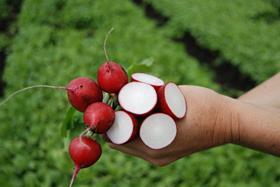
Dominating 90 per cent of the radish market in France, the French Breakfast radish is barrel shaped and milder than standard red round types. A traditional element of French cuisine, this elongated radish – with roots two-thirds crimson to a third white, has a subtle flavour, attracting a healthy premium.
With around an 80 per cent share of the total UK radish market sold through major retailers, Feltwell Growers is one of the leading growers in the sector. A member of G’s Growers, Feltwell grows radishes on 270ha of black soils near Thetford in Norfolk. With radish production reaching a staggering 6,000 tonnes a year it is a little surprising that just 10 per cent are French Breakfast.
“In many European countries, radish is predominantly sold bunched with the tops on,” explains Feltwell general manager Scott Watson. “In the UK, red round radish is sold pre-packed through major retailers. French Breakfast is the exception, sold bunched - the leafy tops must therefore be healthy and green.”
However, he believes UK retailers are missing a trick. “While UK consumption of French Breakfast radish is slowly increasing, moving to a pre-pack format would not only extend the shelf life, but improve its shelf appeal,” he says.
Hazera Seeds’ market development manager, John de Soyza, believes UK consumers are also missing out. “French Breakfast is currently underused. With an appealing flavour and more practical shape, it offers great versatility,” he says. “The mild peppery taste and crunchy texture make French Breakfast radishes ideal as a snack on their own or with a dip such as tomato salsa or tzatziki. They can be baked, grilled, stir fried, caramelised or roasted, and of course eaten raw in sandwiches, salads and coleslaw. They can even be used in drinks – Radish Bloody Mary and a detox radish juice.”
Feltwell produces radish on some of the best land in Europe. “The high organic matter of our soil creates excellent water-holding capacity,” explains Watson. “Radish is 90 per cent water, while the soft texture of the soil also minimises root abrasion at harvest.”
Operating an intense drilling programme, with 28 rows per bed, Feltwell drills at almost double the seed rate of European growers. “We drill at 3.6 million seeds per hectare,” explains technical assistant Erika Banszky. “On this highly fertile land at this high drilling density we get the right size radish and it benefits weed control.”
With a crop cycle of 17-18 days, French Breakfast is among the quickest-growing radish types. A narrow harvest window of 48 hours makes precision programming vital to provide continuity of supply and avoid pithiness. This year, drilling commenced on 23 January, whereas last year it was later on 2 February. The first drillings take 60 days to crop maturity with harvesting commencing mid-April. If the soil is sufficiently dry, crops are drilled six days a week, from January to September.
Cabbage root fly is the number-one pest and Feltwell adopts an integrated pest management approach with early drillings covered with fleece, which is replaced with Enviromesh six weeks later. Later drillings skip the fleece stage. “In the main season, the mesh stays on from drilling till one week before harvest,” explains Banszky. “We’ve had to reduce the mesh size as the pest has evolved and was starting to lay its eggs through it.”
Harvesting
It can be advantageous to hold on to a crop to get the best possible yield. “Holding on to a 1ha crop of radish for an extra day can produce a yield increase of three to five tonnes,” says Watson. “However, there are strict UK retailer specifications – and delaying harvesting can lead to pithiness – particularly in French Breakfast varieties. It’s a careful balancing act.”
While demand was slow at the beginning of the 2017 season, during June Feltwell was harvesting upwards of a million packs of radish a week as the sun came out across the UK.
The round red radishes are mechanically harvested using a bespoke harvester. French Breakfast continues to be hand harvested and bunched.
Once harvested, the crop is washed at the on-farm washing facilities before being packed at G’s facilities. While over £5m has been invested in this large-scale radish operation over the past decade, there are plans to further upgrade the onsite wash lines, from three to five lines, during the downtime from October to April.
New varieties
Led by Banszky, Feltwell constantly trials different radish varieties. French Breakfast radish production relies on Vilmorin (Hazera) variety Expo, while Enza Zaden, Rijk Zwaan and Hazera supply round red varieties.
Banszky oversees the trial plots. She is working closely with Hazera’s product development specialist Andrew Brown, as well as de Soyza, on early stage screening, testing new Hazera material under commercial conditions.
“Mildew can be an issue, particularly at high planting density and with crop covers,” explains de Soyza. “High irrigation levels can also contribute to mildew problems. We’re working in this commercial situation to select red round varieties with improved mildew tolerance. Employing local selection, we’ve identified two promising newcomers in the Celesta (Enza Zaden) bracket – Fabuloso (34-211) and coded variety 34-277.”
“Other desirable traits include improvements in crop uniformity and splitting tolerance,” says Banszky. “While still at an early stage, we expect the programme to progress quickly as it concentrates on Feltwell’s specific needs and soil types. With the trials on site we can take immediate action – there is lots of promising material coming through.”



